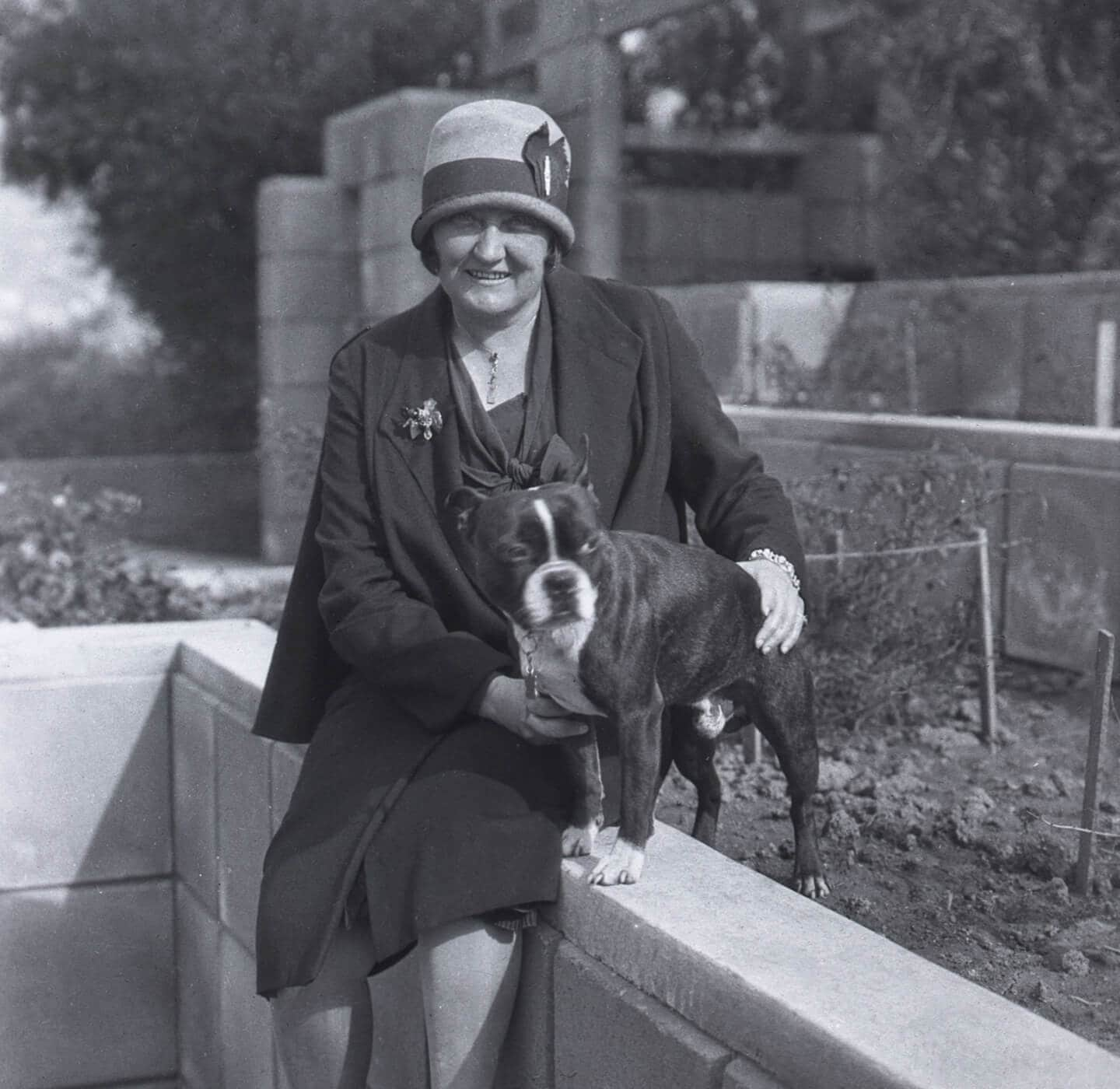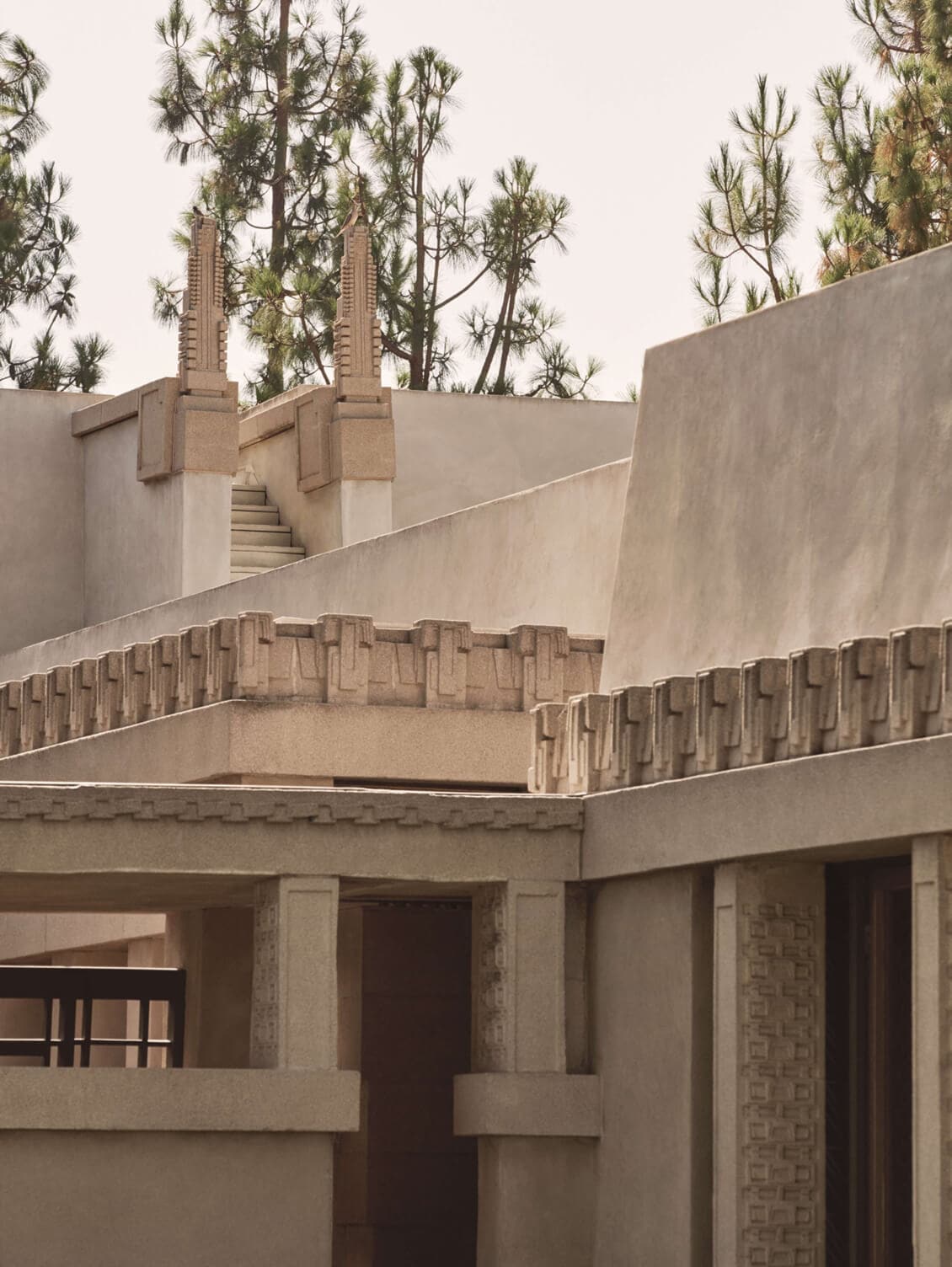Oliver Peoples honors LA’s first ever UNESCO World Heritage Site, Hollyhock House and its commissioner, Aline Barnsdall who paved the way for California’s mid-century masterpieces.
Aline Barnsdall was a true pioneer, one of the most unique and renegade bohemians among a heroic legacy of many that migrated to Los Angeles in the early 20th century seeking freedom from puritanical conventions and forging new lives on the new frontier. You could have labeled her a devout feminist, a radical, or a progressive. She was always a rebel, intentionally having a child out of wedlock, which was wildly scandalous at the time since she considered marriage archaic. Her goal was to change the face and direction of the arts. To that end, Aline headed west. She felt Los Angeles was the place to do this and considered New York the "worst possible place for creative people." Aline wanted a blank canvas not bound to tradition, or the past. She was also a multimillionaire. Oil that is, black gold, Texas tea.

Hollyhock House, Frank Lloyd Wright’s ode to California.
In 1919, Aline hired Frank Lloyd Wright, the most controversial and avant-garde architect she knew of to design a cultural acropolis to be named Olive Hill. The property perched atop a thirty-six acre gentle mound that stretched from Hollywood Blvd to Sunset Blvd and Vermont Ave to Edgemont Ave. Put on your time machine goggles and wipe out the hospitals and strip malls now squatting at the base of this Hollywood hill. The vacant land had been for sale for some time at $10,000 an acre when Aline offered to pay cash, she was sold the property of thirty-six acres for $300,000.
Aline's vision was a multi-disciplinary "art park," where during experimental theater intermissions attendees would stroll the hilltop citadel, hold political discussions during dinners on the roof garden, and dancers would frolic among the olive trees, under the stars and moon, blissfully away from conventional society. This getaway would be Aline’s brave new world where she would raise her enlightened daughter.
With Olive Hill, Aline urged Wright to expand his horizons through the creation of a new architecture for a new region and age. The campus would have a theater, lodgings for artists and actors, a cinema, and even a progressive kindergarten —altogether nineteen buildings to be designed by Wright. Aline's own home, Hollyhock House, would be at the pinnacle of Olive Hill from which she would oversee her artistic fiefdom. Aline wanted to encourage and explore everything New—theater, dance, film—all the arts.
At her encouragement, Hollyhock became the first great home of Wright's famous second period. During this era, he abruptly transitions from his famous Prairie style and instead looks to pre-Spanish and Japanese architecture to find elements that would best serve this new, modern California. Due to the moderate climate, Hollyhock is also Wright's first courtyard house that includes a very Californian open floor plan with seamless boundaries between indoor and outdoor zones.
For this ambitious project, Wright chose to base his design primarily off of a pre-Columbian temple form. Wright had been very interested in the architecture of early Mesoamerica since he was a boy. He recalled in a 1930 lecture how the style "stirred my wonder and excited my wishful imagination." Some say Wright was also influenced when he was in Chicago working for Louis Sullivan. There, Wright repeatedly visited the great Columbian Exposition World's Fair of 1893 where full-scale replicas of several Mayan structures were on display. He was smitten with this aesthetic and finally got to exercise this fascination fully in Hollywood where faux Tudor houses sat next door to Oriental bungalows and Mediterranean Revival casitas. The whole town resembled a studio backlot of exotic places and influences. At the same time Hollyhock was under construction, a few blocks away, one of the largest outdoor film sets ever constructed, for D.W. Griffith's epic Intolerance, still stood at the corner of Sunset and Virgil in all its artificial Babylonian glory.
Hollywood was truly a pottage of architectural styles and influences quavering between fabulism and fantasy.
Hollyhock is architecturally characterized by its massiveness and monumentality connoting a solidity and connection to the earth, protruding out of the ground, a "mountaintop" on top of the mountain. The outward sloping walls featured in the house are called taluds and are decorated with various pre-Columbian style ornaments. Throughout Hollyhock, Wright incorporated many decorative planters and flower boxes. Vintage photos reveal overgrown flowers, plants, and cascading succulents everywhere. The whole house was covered and dripped with the enveloping blanket of nature. Exterior stairways meandered up and down the rooftops turning and affording various directional views; it is all a dizzying experience winding indoors and back out, up and down, then back inside again in almost dazing euphoria.
Brad Dunning
What is underappreciated is the impact Barnsdall herself had on Los Angeles culture. There is no telling of the cross pollination she encouraged, the people she introduced, and the financial and support she provided to the arts community.
Although often erroneously thought of as a concrete structure, the house is actually hollow tiled wall masonry with skim coat and applied cast concrete adornment. This design detail is most notable throughout the almost sci-fi, futuristic-modern-primitive geometric interpretations of the Hollyhock flower, which Wright applied liberally when he found out it was Aline's favorite blossom. Apparently, even F.L.W. could kowtow to a client.
The drama of a Wright-designed entrance is one of his signatures. He tends to lower ceilings to almost claustrophobic proportions (in the case of the Hollyhock entry approach just 6'7" tall). Then once entering the house, the space expands, and the height opens up dramatically as if setting foot into a vast sacred tomb from a dark, forbidden tunnel. Compression/release it is called.
Today, one could argue Hollyhock is even more attractive than when it was first built. This Mayan/pre-Columbian style is associated to modern man with antiquity.
Every crack, crumble, and stain helps the house look authentic and mysterious. The romance of ruins indeed. The patina of time.
Since Barnsdall knew what she wanted for the interior decoration, Wright only designed the furnishings for the living and dining room. The rest of the house was filled with furniture and art Aline had collected throughout her world travels.
The Wright-designed living room is an intoxicant; it has been called "an altar to art and nature," and on a clear day, the reflection of sunlight on the Pacific Ocean can be seen. The cast-concrete fireplace featured is considered to be one of Wright's greatest two-dimensional works of art ever, complete with a skylight above and a moat. An elaborate system of both interior and exterior pools and fountains were interconnected with streaming water throughout the house, again combining outside and inside, although (very) sadly not in operation today.

The circular design of the fountain is inspired by Greek Theatres.
The pairing of primal fire and water, at the living room fireplace with a transparent skylight above, is a seriously masterful gesture, and it is a shame we cannot experience it as he designed with all three elements on display.
Since Wright was simultaneously working on the Imperial Hotel in Tokyo, he incorporated many Japanese details in the design of the Hollyhock House. Along with the screens in the living room, there's also a Buddhist sculpture at the end of a long hallway that's lined with art glass produced at the still-in-business today Judson Studios in nearby Highland Park. Wright designed four other houses in Los Angeles during his fertile 1920's transitional period in a similar, fantastical and exotic style: the Storer House (1922) the Freeman House (1923), Millard House (1923), and Ennis House (1924).
A singularly, sublime L.A. architectural and historical vision can be had by looking north from Hollyhock House and spotting the Ennis House on the hill, spiritual sisters they are. It is almost miraculous the pair have survived and are now international treasures when not long ago both were threatened with either benign neglect and/or public misunderstanding of their worth.As Wright was needed more and more in Tokyo for the Imperial Hotel project, in his absence, he summoned west an employee, young Rudolph Schindler, to oversee the Barnsdall project. To help with landscaping Schindler called upon Richard Neutra to also head westward.
Wright's bringing Schindler and Neutra to California is yet another gift we can thank Aline Barnsdall tangentially for. On their own, Schindler and Neutra would both go on, post-Wright, to create some of the most unique and treasured architecture in Southern California. Over time, given the lack of promised drawings from Wright himself, especially the final drawings for the theater, the project closest to Aline’s heart, and not to mention the ballooning costs, made her grow weary of the big project and slowly lose enthusiasm and patience. Aline reportedly fired Wright in 1921 and the acrimony over that action took years to mend which greatly limited her time at her cherished, vision of a home.
Carol LeFlufy, the owner of Eye Forward, an agency representing photographers and directors, is but one of many professionals that volunteer as docents in their spare time, comments, "I think the most surprising fact about the house to most visitors is that Aline Barnsdall never officially moved in and in fact started working very soon after firing Wright to donate the house to the City of Los Angeles."
The only portions of Olive Hill complex that were completed were the main house itself, Hollyhock, the garage, and two guesthouses—one of which no longer stands today. Aline graciously donated most of the property to the city of Los Angeles in 1927 but continued to live part-time in L.A. until 1946 when she passed away in "Residence B," one of the guest houses, which was still kept in the family name.
Quite frankly, the City of Los Angeles did not know what to do with the gift. The house went through many years of being rented out, thwarted plans, and unworthy tenants. Shockingly, for about fifteen years, the house was boarded up, yet people trespassed, partied, and hauled away the custom furniture. One particular puzzling, mysterious and sad loss—the entire original custom living room set, designed by Wright and weighing more than a ton, was taken sometime between World War II and 1974.
Unfortunately, it has never surfaced since and no doubt remains hidden away in some mad collector's vault or shadowy lair. Thus, many of the furniture pieces in the house today are quite faithful copies based on period photographs and drawings but nonetheless reproductions. However, the dining room suite is original and designed by Wright.
On July 7, 2019, Hollyhock House was declared a UNESCO World Heritage Site, a huge and prestigious honor. It and seven other Wright-designed structures were collectively inscribed as a serial nomination entitled “The 20th Century Architecture of Frank Lloyd Wright.” This recognition makes Hollyhock House one of the "most important cultural structures on the planet" in addition to becoming Los Angeles’ first-ever UNESCO World Heritage Site.
Wright, who said about Hollyhock House years later to Aline, after their relationship was somewhat mended — "The building stands. It is yours for what it has cost you. It is mine for what it has cost me…and it is for all mankind."
What is incalculable and underappreciated is the impact Barnsdall herself had on Los Angeles culture. There is no quantifying or telling, of the cross-pollination she encouraged, the people she introduced, and the financial and emotional support she generously provided to the arts community. We see the three-dimensional work of Wright and justly appreciate it. Aline remains an unsung hero, who gave us a monument.
Words: Brad Dunning
Photos: Rich Stapleton


















